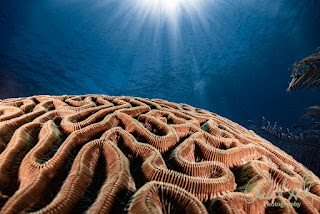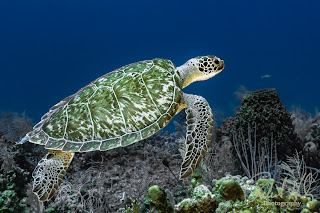A Beginner’s Guide to Underwater Macro Photography: From Cell Phones to DSLR Systems
Introduction:
Have you ever noticed that most photographers shoot macro photography over wide-angle photography?
Today, underwater photographers are divided between two main styles: macro and wide-angle photography. Their choice largely depends on
their interests, location, and the marine life they want to capture.
Macro Photography is incredibly popular among
underwater photographers because it allows them to focus on the intricate
details of small subjects like nudibranchs, tiny crustaceans, and colorful
coral formations. Macro photographers often enjoy the challenge of finding these
little creatures, which are sometimes overlooked but can offer stunning close-up
images. The appeal of macro photography also comes from its accessibility –
even in areas with poor visibility, macro subjects can still be photographed up
close, making it ideal for divers in less-than-perfect conditions.
On the other hand, wide-angle photography is favored
by those looking to capture the grandeur of underwater landscapes, significant marine
life like sharks, manta rays, or schools of fish, and striking reef scenes. The
wide-angle lens allows photographers to get close to significant subjects while still
fitting them in the frame, often creating a sense of scale that draws the
viewer into the image. This style thrives in clear, open water where visibility
is good, allowing photographers to showcase the vastness and beauty of the
underwater world.
Many underwater photographers switch between the two styles depending on their dive location and the conditions. Some specialize in one over the other, but it's common to see professionals and enthusiasts carry equipment that allows them to switch between macro and wide-angle, maximizing their underwater opportunities.
Macro photography is ideal for capturing small, colorful, and unique underwater creatures in great detail. On the other hand, wide-angle photography is preferred for showcasing the vastness and grandeur of the underwater environment and its larger inhabitants. Both styles are equally important in underwater photography, and many photographers enjoy mastering both to capture the full spectrum of marine life.
In today's blog post, I want to explore underwater macro photography. It offers a fascinating way to capture the intricate details of marine life, from tiny nudibranchs to the delicate textures of coral. Whether you're using a smartphone, a compact camera, or a high-end mirrorless or DSLR system, there are plenty of ways to dive into this exciting photography genre. In this guide, we'll cover essential equipment for each type of camera, lighting techniques, and key camera settings, ensuring you're well-equipped to start creating stunning underwater macro images.
1. Essential Equipment for Underwater Macro Photography
1.1 Cell Phones
Cell phones have evolved dramatically in recent years,
offering powerful cameras capable of impressive macro shots. With
the right equipment, you can take excellent underwater macro photos using your smartphone.
- Waterproof
Housing: Cell phones aren't waterproof to significant depths, so you'll need durable housing. Brands like SeaLife, Kraken
Sports, and Catalyst offer housings designed for underwater use
that allow you to take your smartphone to depths of up to 60 meters or
more.
- Attachable Macro Lenses: An external macro lens is an essential smartphone accessory for underwater macro photography. The Kraken KRL-03 Wet Macro Lens or Moment Macro Lenses are great options. These lenses allow your phone to focus on small subjects, bringing tiny marine life into sharp detail.
- External
Lighting: Smartphones lack built-in underwater lighting, so you'll
need an external light source. Kraken Hydra 3500 or SeaLife Sea
Dragon 2500 lights are compact and powerful, helping to illuminate
your subject and enhance its colors.
1.2 Compact Cameras
Compact cameras are a great middle-ground option. They offer more manual control and higher image quality than smartphones while being relatively affordable and portable.
- Macro
Lenses: Compact cameras often benefit from wet macro lenses like the Nauticam CMC-1 or Subsee Magnifier. These lenses can
be attached and removed underwater, allowing flexibility between macro and
wide-angle shots during a single dive.
- Underwater
Housing: Ensure your compact camera is paired with reliable housing that allows you to control its manual settings completely. Brands like Fantasea
and Ikelite are popular choices for compact camera housings.
- Strobes
and Focus Lights: Compact cameras benefit significantly from external
strobes like the Inon S-2000 or Sea & Sea YS-03. These
strobes provide intense, even lighting that helps reduce shadows and
eliminate backscatter. A focus light can assist in low-light conditions,
enabling your camera to focus more accurately on small subjects.
1.3 Mirrorless or DSLR Cameras
For the highest image quality and the most control over
settings, mirrorless or DSLR cameras are the go-to systems for serious
underwater photographers.
- Macro
Lenses: Dedicated macro lenses with mirrorless or DSLR cameras are crucial for underwater macro photography. The 60mm and 100mm
macro lenses are common choices, and their longer focal lengths allow you to shoot tiny subjects from a greater distance without disturbing
them.
- Underwater
Housing: You'll need a custom-fit housing that supports all your camera controls, like those from Nauticam or Subal.
These housings offer full access to manual settings and accommodate
accessories like external strobes, focus lights, and wet lenses.
- Dual
Strobes: Consider using dual strobes such as the Sea & Sea YS-D3 or Inon Z330 for more advanced lighting control. Dual
strobes help evenly light your subject from both sides, reducing shadows
and increasing depth in your images.
- Buoyancy
Arms and Trays: With bulkier mirrorless or DSLR setups, buoyancy arms, and trays can make handling underwater easier. Buoyancy arms
help offset the weight of your rig, making it more neutrally buoyant and
comfortable to maneuver.
2. Lighting Tips for Underwater Macro Photography
Regardless of your camera system, lighting is crucial in underwater macro photography. The deeper you dive, the less
natural light is available, so external lights or strobes become essential.
2.1 Lighting for Cell Phones
You'll need external lights since smartphones don't have built-in underwater lighting. Kraken Hydra 3500 or SeaLife Sea Dragon
lights are excellent options for smartphone setups. They offer bright, even
illumination that brings out the vibrant colors of marine life. Position your light slightly to the side or above your subject to prevent harsh shadows.
2.2 Lighting for Compact Cameras
Compact cameras benefit from the use of external strobes or
focus lights. Place a single strobe slightly above and to the
side of your subject to create depth. A focus light can be invaluable in
low-light conditions, helping your camera lock focus quickly and accurately.
Many strobes come with built-in focus lights to make this easier.
2.3 Lighting for Mirrorless or DSLR Cameras
With more advanced setups, you can use dual strobes to
achieve balanced lighting. Position your strobes at a 10 and 2 o'clock
angle, slightly angled outward, to avoid front lighting, which can create flat
images. By angling your strobes, you'll bring out the textures of your subject
while reducing backscatter.
Using diffusers on your strobes or lights helps soften the
illumination, preventing overexposure and providing a more natural look.
Side-lighting can also highlight fine details, like the ridges on a nudibranch
or the texture of coral.
3. Camera Settings for Macro Photography
Your camera settings are vital to achieving sharp, detailed
macro shots. Understanding the correct settings will ensure the best results whether you're using a smartphone, compact, or DSLR.
3.1 Smartphone Settings
- Manual
Mode: Many smartphones now offer manual settings through built-in
features or apps like ProCam or Halide. Adjust the ISO,
shutter speed, and white balance manually for better control.
- ISO:
Keep the ISO low to minimize noise. Start with ISO 100-200, increasing
only if necessary in darker environments.
- Focus:
Use touch focus to lock onto your subject. Many newer smartphones allow manual focus adjustment, useful when working with tiny,
complex subjects.
- Shutter
Speed: To avoid motion blur, use a shutter speed of at least 1/125,
especially for moving subjects or in low-light conditions.
3.2 Compact Camera Settings
- Aperture:
Set the aperture to f/8 to f/16 for a balanced depth of field,
ensuring that more of your subject is focused while maintaining a
pleasing background blur.
- Shutter
Speed: Use a fast shutter speed of 1/125 to 1/250 to freeze
motion, as even slight underwater currents can blur your shot.
- ISO:
Keep the ISO as low as possible (ISO 100-200) to reduce noise in your
images. Increase it only if needed in darker environments.
- Manual
Focus: Autofocus can struggle underwater, especially in low light or
with complex backgrounds. Using manual focus ensures you lock onto the
exact point of interest.
3.3 Mirrorless or DSLR Camera Settings
- Aperture:
Use a small aperture (high f-stop) like f/16 to f/22 to increase
the depth of field and keep more of your subject in focus.
- Shutter
Speed: Maintain a shutter speed of at least 1/200 to eliminate
motion blur caused by water movement or fast-moving subjects.
- ISO: To avoid noise, keep the ISO as low as possible, starting with ISO 100 and
only increasing it if absolutely necessary.
- Manual
Focus: In macro photography, manual focus is often more reliable than
autofocus. Focus peaking (if available on your camera) can help you
see exactly which parts of your subject are in sharp focus.
4. Practice, Patience, and Dive Conditions
No matter which camera system you're using, underwater macro
photography takes time to master. Start practicing with stationary or
slow-moving subjects like coral or sea slugs in calm, clear water. Pay
attention to dive conditions, as strong currents and poor visibility can make capturing sharp, clear images difficult. Night or muck dives are
often ideal for macro photography, as many small critters emerge after dark.
5. Subject Choice
When you're starting, look for subjects like nudibranchs,
small shrimp, or colorful coral, which offer exciting opportunities for macro
shots. These subjects are often slow-moving or stationary, giving you time to
experiment with settings and lighting.
Whether using a cell phone, compact camera, or a mirrorless or DSLR system, the key to stunning underwater macro photography lies in the right equipment, proper lighting, and thoughtful camera settings. With practice, you'll be able to capture the hidden beauty of the ocean's smallest creatures, showcasing the incredible details that often go unnoticed. Dive in and explore the intricate world of underwater macro photography!
Stay Connected
Follow my blog for more tips and tutorials on underwater photography. Let's dive deeper into the art and craft of capturing the marine world!
Subscribe to my blog for more tips and tutorials on underwater photography. Don't forget to share your processed photos on social media using the hashtag #RobertHerbPhotography. I look forward to reviewing your results.
New Online Training Program
I am excited to announce that I am creating an online training program to teach underwater hobbyists and enthusiasts how to enhance their photos using Adobe Lightroom. If you are interested in this training or need more information, please go to (Underwater Photo Training) or contact me at bob@robertherb.com to express your interest and to be notified about the details and start date of the classes.
Stay tuned and "Follow" for upcoming blogs on underwater photography tips and tricks for more in-depth insights. Please leave your comments and suggestions. Enjoy your diving and shooting experience!
I am eagerly anticipating your valuable feedback and suggestions.
Sincerely,
Bob Herb
|
|






Comments
Post a Comment
Please let me know your comments.